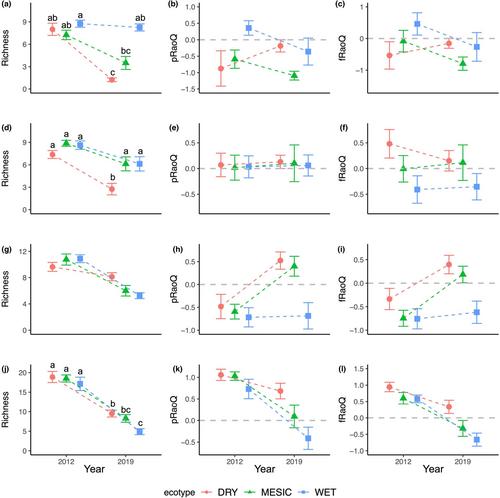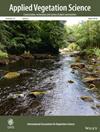The role of dominant prairie species ecotypes on plant diversity patterns of restored grasslands across a rainfall gradient in the US Great Plains
Abstract
Questions
A robust ecosystem requires a functionally heterogeneous community of organisms with ecological traits that permit broad resource partitioning. Understanding community diversity patterns can help investigate drivers of community assembly and assess restoration success. Do biodiversity patterns differ among grassland communities sown with different ecotypes of dominant species during restoration along a rainfall gradient in the tallgrass prairie of the central US Great Plains?
Location
Four field sites across a rainfall gradient within the North American Great Plains: Colby, Kansas (39°23′17.8″N, 101°04′57.4″W), Hays, Kansas (38°51′13.2″N, 99°19′08.6″W), Manhattan, Kansas (39°08′22.3″N, 96°38′23.3″W), and Carbondale, Illinois (IL, 37°41′47.0″N, 89°14′19.2″W).
Methods
We applied linear mixed models to assess the effect of dominant species ecotype, year, and location on grassland taxonomic, phylogenetic, and functional diversity.
Results
The non-local grass ecotype (compared to the local ecotype) promoted species richness. In contrast, the effect of the dominant species ecotype on phylogenetic or functional diversity was site-specific over the 10-year restoration. Richness decreased across the rainfall gradient from dry to moist sites, and the wettest site had the highest phylogenetic and functional diversity.
Conclusions
Our results suggest that abiotic filtering by rainfall is a key assembly mechanism that could predict grassland changes in biodiversity in the early restoration phases. Given the community response across the tallgrass prairie, restoration practitioners should consider the impact of regional sources of dominant species used in restoration when biodiversity is a restoration goal. It is recommended for future grassland restoration to detect gaps and limitations in evolutionary and trait structure that will reveal which diversity components to evaluate.


 求助内容:
求助内容: 应助结果提醒方式:
应助结果提醒方式:


